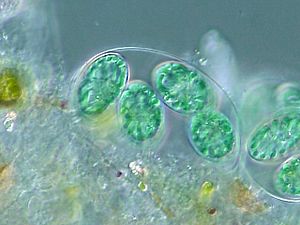Glaucophyte facts for kids
Quick facts for kids Glaucophyta |
|
|---|---|
 |
|
| Glaucocystis sp. | |
| Scientific classification |
|
| (unranked): | Archaeplastida |
| Division: | Glaucophyta Skuja 1948 |
| Class | |
|
|
| Synonyms | |
|
|
The glaucophytes are a small group of tiny freshwater algae. You can only see them with a microscope! They are part of a bigger group called Archaeplastida. This group also includes red algae and green algae (which are related to land plants).
Scientists are very interested in glaucophytes. They might be similar to the very first algae that led to all green plants and red algae. We don't fully understand how these groups are related yet. Glaucophytes especially need more study to unlock their secrets!
What Makes Glaucophytes Special?
The special parts inside glaucophytes that make food from sunlight are called chloroplasts. But these chloroplasts are also known as 'cyanelles'. What makes them unique? They have a special outer layer called peptidoglycan. This layer is usually found in the cell walls of bacteria.
Scientists think this peptidoglycan layer is a clue from a long, long time ago. It suggests that chloroplasts originally came from cyanobacteria. These tiny bacteria started living inside other cells, and over time, they became the chloroplasts we see today.
Glaucophytes use a green color called chlorophyll a to capture sunlight. They also have special red and blue pigments called phycobiliproteins. These are the same pigments found in cyanobacteria and red algae. Interestingly, green algae and land plants have lost these phycobiliproteins.
The powerhouses of the cell, called mitochondria, in glaucophytes look similar to those in some green algae. If glaucophytes have tiny tails for moving around (called flagella), they also look like the ones found in some green algae.
Where Do Glaucophytes Fit In?
There are only about 13 known types (species) of glaucophytes. They aren't very common in nature. These species belong to just three main groups, or genera.
In the past, glaucophytes were sometimes placed in a different group called Chlorococcales. But now, scientists have given them their own special place in the tree of life.
See also
 In Spanish: Glaucofitas para niños
In Spanish: Glaucofitas para niños

